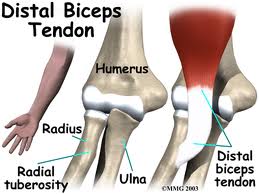I do many distal biceps tendon repairs every year. I have only recently performed these repairs through a single incision with an endobutton (a special kind of anchor device which holds the tendon to the bone) with great success. I had one case where the endobutton would not hold the tendon in place and I had to resort to the standard technique. That case turned out well but proved to me that new technology is not always better and you always have to have a plan B if plan A does not work. After 20 years of experience, I had a plan B and beyond. For years, however, I only performed these biceps ruptures from the elbow through a 2 incision technique. I believed that the research and my experience confirmed that the 2 incision technique was the gold standard with the lowest rate of complications. The below study seems to confirm that premise. I would still use the single incision technique in selected cases.
Read on from the AAOS…
Patients treated with double-incision repair using transosseous drill holes for acute distal biceps rupture may see fewer complications than those treated with single-incision repair using suture anchors, according to the results of a prospective, randomized clinical trial presented at the 2010 ASSH annual meeting.
| An intra operative photo of a single incision repair using endobutton anchor. This ruptured tendon will be reinserted into the bone. |
The researchers randomized 90 male patients to receive either single-incision repair (n = 48) or double-incision repair (n = 42). The two groups had no significant differences in patient age, dominant hand, or number of workers compensation cases. Overall mean American Shoulder and Elbow Society pain scores were similar in both groups at all follow-up points (3, 6, 12, and 24 months).
At 24 months, no significant differences were found between the treatment groups in final extension, pronation, or supination. The research team noted a marginal advantage in mean isometric flexion strength regained among participants in the double-incision group (double: 104 percent; single: 94 percent; p = 0.01).
JTM comment: Double incision technique seems to result in superior strength at least in this study.
Overall, 19 of 48 patients in the single-incision group had complications, compared to 3 of 42 in the double-incision group (p < 0.01)—primarily due to a high number of early transient neuropraxias in the single-incision group. Three neuropraxias in the single-incision group remained symptomatic after 6 months.
JTM comment: Wow, that’s a lot of complication in the single incision group. Seems like their surgical exposure made seeing the tendon more difficult and they ended up stretching the sensory nerve to see better. This resulted in a neuropraxia, or stretched nerve, which took at least 6 months to recover. While the 2 incision technique does reduce the chances of this happening, I have not seen this complication in the single incision cases that i have performed. In fact, I have had no complications in the single incision repairs that I have performed.
The researchers noted four tendon ruptures, all of which were due to noncompliance or reinjury in the early postoperative period. None of the ruptures was related to fixation technique.
JTM comment: Tendons re-ruptured because patients did not listen to the doctor. Where have I heard this before.
Bottom line
 |
| The perfect repair. |
No overall differences in functional outcomes were found between distal biceps ruptures treated with either a single or double incision repair technique; however flexion strength was slightly greater with a two-incision technique.
- The single-incision group had a greater incidence of complications.
AAOS Now December 2010 Issue http://www.aaos.org/news/aaosnow/dec10/clinical9.asp
You can get some additional information on biceps tendon ruptures at the elbow here and here and here.
Thanks,
JTM, MD

